We’ve just passed two years of living on a micro-farm in Seattle, so this is sure to be a long and newsy post. It’s been fun to remember what it looked like before we got started and how it is now. Unfortunately, we didn’t take many before photos, so the blackberry-ivy thicket that completely obscured the rock wall and the gravel walkways between the “raised”–maybe 12-inch tall, termite-infested–garden beds and the dirt the chickens used to scratch in live only in memory.
Nearly as soon as we moved in we got on the Chip Drop list, so we could try Back to Eden style deep mulch gardening. It took something like a month to get the wood chips delivered. Carl and I (mostly Carl) spent hours moving the wood chips onto the garden and chicken run. At first, the chickens freaked out about the new surface, and would run over the wood chips as fast as possible between islands of yet uncovered dirt.
Before the wood chips, the run area was packed dirt. the chickens scratched at it, but didn’t make much headway. It was dry and when a chicken pooped on it, you had to watch your step or get goop off your shoes. We put down about six to eight inches of wood chips across both run and garden.

Now the wood chips are about three inches deep in the higher places and eighteen inches deep at the bottom of the hill. Post wood chips, the chickens routinely “dig to China,” and we can walk across the run without as much fear of sticky goop. It can still happen, but the vast majority of the deposits are turned under within a few hours and absorbed by the mulch. I routinely walk across in the dark and my shoes look fine when I get back to the house.
The wood chips have gradually turned from a light wood color, with readily distinguished particles of wood and leaf material to a dark blackish-brown color that looks more like good soil with some dark, well rounded little chunks of bark that continually float to the surface.

Chickens scratching in wood chips
In the garden, we’ve learned a lot about growing in wood chips in two seasons. The first year, the wood chips were coarse and heavy, and the supply of nitrogen available for plants was low enough that I top dressed my hungry plants (zucchini) with some organic steer manure about half way through the season. They went from a bit yellow on the edges to bright green nearly overnight, and produced so much squash that even the chickens seemed to get tired of it.
We also learned that the coarse wood chips were too coarse for many seeds to be planted in, even when we (attempted to) push the wood chips aside and plant in the dirt. Things with big seeds or plant parts, like corn, beans, potatoes, and transplants did great as a rule. Things with tiny seeds especially carrots, onions, and the like disappeared into the wood chips never to be seen or heard from again, despite our efforts to keep the wood chips at bay while they germinated.
One of the amazing things that first year was how juicy everything was. We had a typically wet Seattle June, followed by a nearly rain-free July. We watered when things were seedlings, then left them to do their thing. We went on vacation for a week in early July and when we returned, the garden had not withered in the heat, but exploded in a furry of green activity.
In our second growing season, this spring, we scrapped the wood chips back where we wanted to plant carrots and sifted a few gallons of “dirt” from the chicken run to put on top of the cleared area. This worked out great (except for an escaped chicken that thought it a good place to dig a hole), and we will definitely be using sifted chicken yard compost in the garden more in the future. In fact, we’re on the list for a refresher chip drop, and the plan is to move the material that is currently in the chicken run onto the garden and give the chickens fresh wood chips to play in.
When I start over again (it’s bound to happen eventually as a renter), I may start in the fall with a large area of chicken run with wood chips and initially not worry about putting deep mulch on the garden, then put the well-composted chicken compost on the bottom of the garden area followed by fresh wood chips if they’re available.
Every time we’ve gardened in the past, weeding has been my least favorite thing and it eats time like crazy! With the wood chips, I mostly don’t have weeds, and when I do have a weed, I usually wait for it to be big enough to feed to the chickens (and get a good grip on) before I pull it up. Things come right out of the ground. There’s so little weeding that I almost miss it. I also seem to do most of the weeding when I’m out harvesting anyway. Pick a cucumber, oh, pull that weed and throw it to the chickens, pick a zucchini.
This year, we had a hot dry June, and I think May was also dry. Despite the wood chips, things have started to look limp and tired a few times, so I’ve watered when it needed it.












